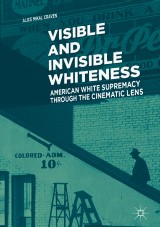Details

Visible and Invisible Whiteness
American White Supremacy through the Cinematic Lens|
96,29 € |
|
| Verlag: | Palgrave Macmillan |
| Format: | |
| Veröffentl.: | 01.06.2018 |
| ISBN/EAN: | 9783319767772 |
| Sprache: | englisch |
Dieses eBook enthält ein Wasserzeichen.
Beschreibungen
<p><i>Visible and Invisible Whiteness</i> examines the complicity between Classical Hollywood narratives or genres and representations of white supremacy in the cinema. Close readings of D.W. Griffith’s <i>The Birth of a Nation</i> by James Agee and James Baldwin explore these authors’ perspectives on the American mythologies which ground Griffith’s film. The intersectionality of Bordwell’s theories on Classical Hollywood Narrative <i>versus</i> Art Cinema and Richard Dyer’s seminal work on whiteness forms the theoretical base for the book. Featured films are those which have been undervalued or banned due to their hybrid natures with respect to Hollywood and Art Cinema techniques, such as Samuel Fuller’s <i>White Dog</i> and Jean Renoir’s <i>The Southerner</i>. The book offers comparative analyses of American studio-based directors as well as European and European <i>émigrés</i> directors. It appeals to scholars of Film Theory, African American and Whiteness Studies. It provides insight for readers concerned about the re-emergence of white supremacist tensions in contemporary America.</p>
<div>1. Looking at American White Supremacy “Through a Glass Darkly”: Baldwin’s Critique of <i>Birth of a Nation</i>.- 2. “But Now I See”: James Agee on <i>Birth of a Nation</i>.- 3. Contending Visions: <i>Imitation of Life</i> According to John M. Stahl and Douglas Sirk.- 4. Forsaking Hollywood: Samuel Fuller’s “art house” <i>White Dog</i>.- 5. A Western by Any Other Name: Rainer Werner Fassbinder’s <i>Whity</i>.- 6. Cream Rises to the Top: Jean Renoir and William Faulkner’s <i>The Southerner</i>.- 7. Supremacy in Black Face: the Boris Vian-Michel Gast Controversy.- 8. Rachid Bouchareb’s Comparative Take on Supremacy.- 9. A Post-Racial Imaginary and the Structures of Cinema.</div>
<p></p><p><b>Alice Mikal Craven </b>is Associate Professor of Comparative Literature and Chair of Film Studies at The American University of Paris, France. In addition to publications on selected authors and filmmakers featured in this volume, she is co-editor of <i>Richard Wright: New Readings in the 21<sup>st</sup> Century</i> (Palgrave 2011) and <i>Richard Wright in a Post-Racial Imaginary</i> (2014), which received a 2015 Outstanding Academic Title award from Choice magazine. She has been invited to give public interventions in Paris on films such as <i>Selma</i> and <i>Dear White People</i>, and on the Black American expatriate community’s perspective on the Franco-Algerian war.</p><p></p>
Offers the first comparative analysis of the film criticism of James Agee and James Baldwin Relates films at the center of debates about the history of American white supremacy on screen with analyses of contemporary films' depiction of the issue and shifting cultural moments Compares depictions of American white supremacy as related through the work of American and European filmmakers
“Alice Mikal Craven has penned a long overdue study of white privilege as a persistent structuring element of classical film language from D.W. Griffith’s Birth of Nation (1915) to Nate Parker’s Birth of Nation (2016) a century later as well as key film texts in between. In a deft Sankofa bird-like move, Craven looks back to James Baldwin’s and James Agee’s insightful yet contrasting analyses of Griffith’s white supremacist grip on global cinema culture to move forward her own powerful deconstruction of discursive whiteness mapped onto various film styles. This grip of stylistic whiteness encompasses film genres, movements, historic epochs, audience demographics, technological shifts, and auteur visions. For anyone seeking a deeper understanding of race and representation in the art and politics of transnational film culture, this book is required reading.” (Anna Everett, Professor of Film and Media Studies, University of California, Santa Barbara, USA)

















